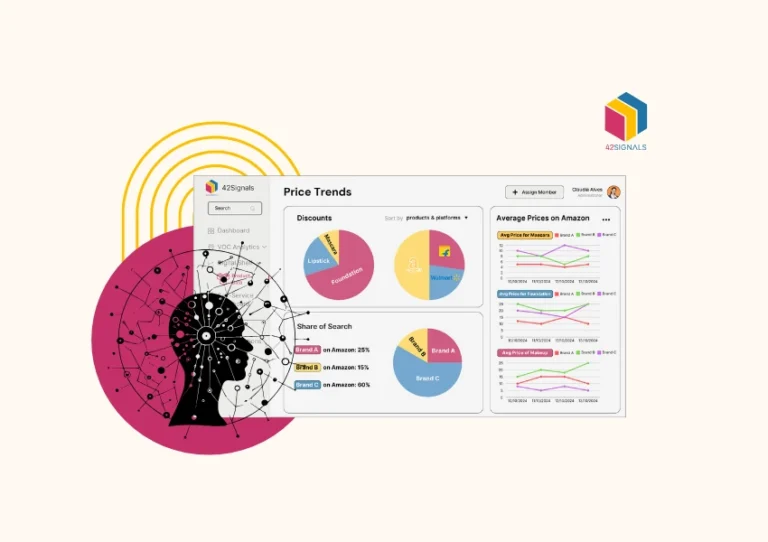What’s the need for competitor monitoring? Whether it’s a global brand or a startup, each competitor in the ecommerce space brings unique strategies and challenges – there are an estimated 12-24 million eCommerce stores active across the world at any given time.
Yeah, that’s a lot of competition, right?
From dynamic pricing models to ever-evolving consumer choices reflected in online reviews, the marketplace is a constantly shifting landscape. Monitoring these changes and benchmarking against industry leaders are not just strategic moves, they are essential practices for ecommerce businesses.
This blog will delve into these vital areas of competitor monitoring and benchmarking, offering insights on how to navigate the challenging e-commerce world. With the right approach and tools, like 42Signals, businesses can transform these challenges into opportunities, paving the way for enhanced market presence and sustained success.
The Imperative of Competitor Monitoring Analysis
Consider the case of an emerging online fashion retailer. By closely monitoring their competitors, they notice a trend: a shift towards sustainable and eco-friendly materials. This observation could spur them to adapt their product line, meeting emerging consumer demands that competitors are already capitalizing on.
Similarly, an online home decor retailer discovers that their rivals are increasingly focusing on augmented reality (AR) features on their websites, allowing customers to visualize products in their own space. This insight could be a catalyst for the retailer to integrate similar technology, meeting the rising customer expectation for interactive online shopping experiences.
Both scenarios illustrate how competitor monitoring provides invaluable insights into market trends, technological advancements, and consumer preferences. It empowers ecommerce brands to make informed decisions on various aspects of their business, from product innovation to customer experience enhancement.
By staying attuned to the competitive landscape, brands can not only keep pace but also identify and leverage opportunities to stand out and succeed.
Benchmarking – Measuring Against the Best
Benchmarking in ecommerce is the process of comparing your business processes and metrics to industry bests. This practice is crucial for understanding where your business stands in relation to the market leaders.
Source: Semrush
For example, if you’re an online beauty retailer, benchmarking could involve comparing your product range, customer service responsiveness, website load time, and checkout process efficiency against top players in the industry. This comparison reveals not just where you align with the industry standards, but more importantly, where you can improve.
It could be in offering a more seamless mobile shopping experience, enhancing customer support, or diversifying product offerings. Benchmarking, therefore, acts as a tool, guiding ecommerce businesses in understanding their market position and identifying actionable areas for improvement.
Strategies for Effective Competitor Monitoring
Leverage Competitor Benchmarking
Today, it’s imperative to understand where you stand in relation to industry leaders. This is where competitor benchmarking becomes a crucial tool. By comparing your business’s performance in areas like pricing, product quality, and customer service against those at the top of your sector, you gain valuable insights into where you excel and where there’s space for refinement.
42Signals supports by providing detailed analytics that focus on these key areas. With 42Signals, you can easily evaluate how your prices compare with competitors, assess the perceived quality of your products through customer feedback analysis, and measure the effectiveness of your customer service.
Conduct Competitor Price Monitoring
Real-time pricing data allows you to react swiftly to market changes, ensuring your pricing strategy is always competitive.
42Signals enhances this process with sophisticated tools that provide up-to-the-minute insights into competitors’ pricing structures. This information is crucial for making informed decisions about your own pricing, whether it involves adjusting prices to stay competitive, launching promotions, or identifying pricing gaps in the market.
With 42Signals, you have the data at your fingertips to make strategic pricing decisions that align with market trends and consumer expectations, ensuring you don’t just compete, but lead in your market segment.
Keep an Eye on Competitor Product Assortment
It’s not just about knowing what they sell; it’s about understanding their approach to market demands, seasonal trends, and customer preferences. 42Signals offers a solution that enables continuous tracking of competitor product assortments.
This constant supervision provides insights into how competitors are diversifying their products, responding to market shifts, or capitalizing on emerging trends.
Competitive Analysis: Turning Data into Insights
Analyzing data from competitor monitoring and benchmarking is a critical step in shaping your ecommerce strategy. Start by identifying patterns and trends in the data, such as changes in pricing, product launches, or shifts in customer sentiment.
Look for correlations between competitors’ strategies and their market performance. Use these insights to identify opportunities and threats in your market segment.
For example, if competitors are lowering prices on certain products, consider how this affects your pricing strategy. Or, if customer reviews highlight a gap in the market, explore how your product could fill this need.
42Signals: Your Ally in Ecommerce Insights
42Signals plays a pivotal role in providing these ecommerce insights. As an advanced tool for competitor monitoring and benchmarking, it simplifies the process of data analysis. 42Signals helps businesses distill large volumes of data into actionable insights.
With its comprehensive analytics, you can easily track competitors’ moves, understand market dynamics, and develop strategies that keep you ahead of the curve.
Whether it’s optimizing pricing, enhancing product offerings, or refining marketing tactics, 42Signals provides the intelligence you need to make data-driven decisions. Get in touch with us at sales@42signals.com
Frequently Asked Questions
What is competition monitoring?
Competition monitoring or Competitor monitoring refers to the process of keeping track of your business rivals’ activities, strategies, strengths, and weaknesses to gain a competitive advantage.
This involves regularly analyzing their marketing campaigns, product offerings, pricing strategies, customer service approaches, and overall performance in the market. By closely watching your competitors, you can identify trends, anticipate changes, and adjust your strategy accordingly.
What are the 4 competitor analysis?
The four components of a thorough competitor analysis typically include:
- Market Position Analysis: Understanding your competitors’ market share, brand recognition, and overall reputation among customers.
- Product and Service Comparison: Evaluating the quality, price point, and differentiation of your competitors’ offerings versus your own.
- SWOT Analysis: Identifying your competitors’ Strengths, Weaknesses, Opportunities, and Threats about your business.
- Strategic Planning: Using the insights gained from the first three components to inform your strategic planning, such as identifying gaps in the market, developing new product ideas, and optimizing your marketing efforts.
What is the tool for tracking competitors?
There are several tools available that specialize in tracking competitors, including:
- SEMrush: A comprehensive SEO and PPC platform that includes features for competitor analysis, keyword tracking, and ad monitoring.
- Moz Pro: Another popular SEO tool that offers site audits, link-building opportunities, and competitor comparison reports.
- Sprout Social: A social media management platform that allows you to schedule posts, monitor mentions, and analyze engagement across multiple channels, including your competitors’.
- Ahrefs: A versatile SEO tool that includes features for backlink analysis, keyword research, and competitor ranking comparisons.
- 42Signals: An e-commerce analytics tool to get detailed insights about competitor strategies, product performance, sales data and much more.





